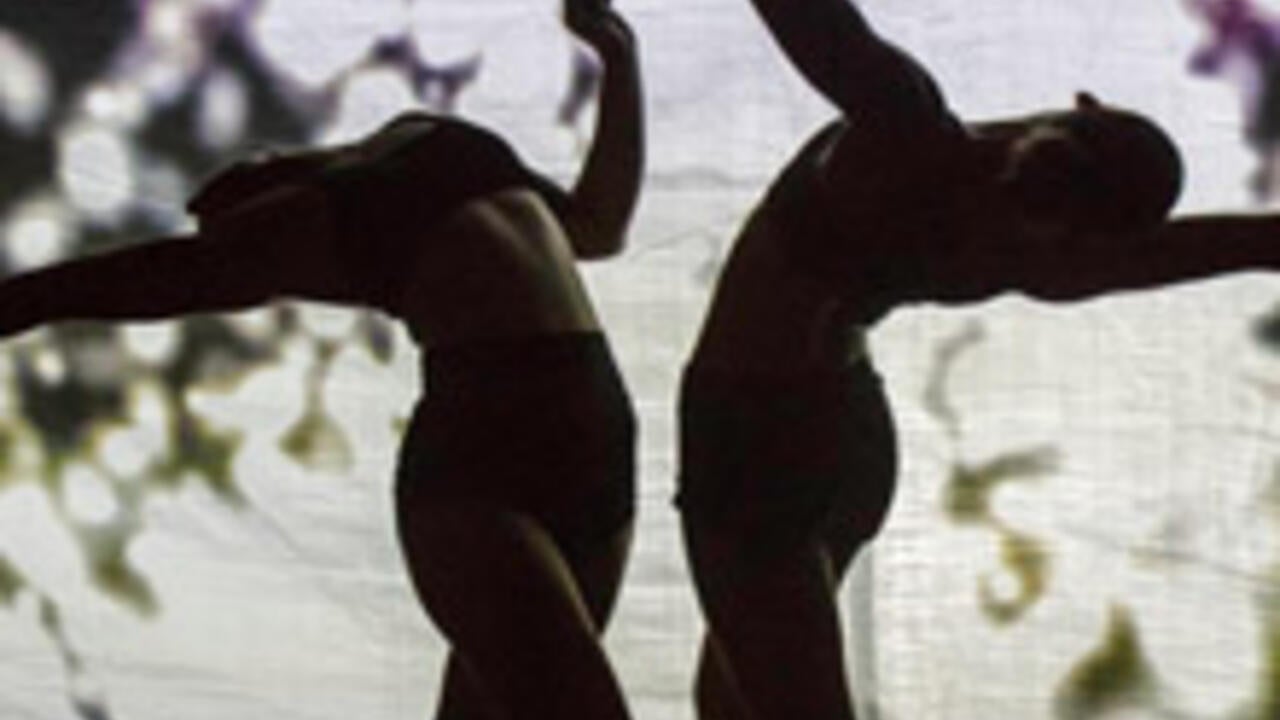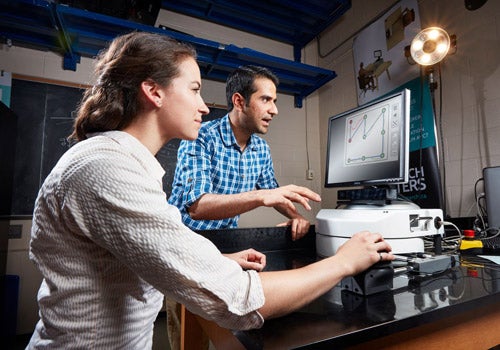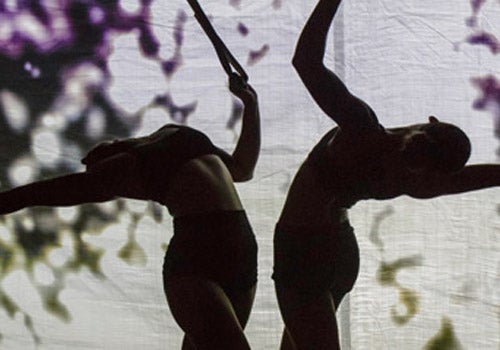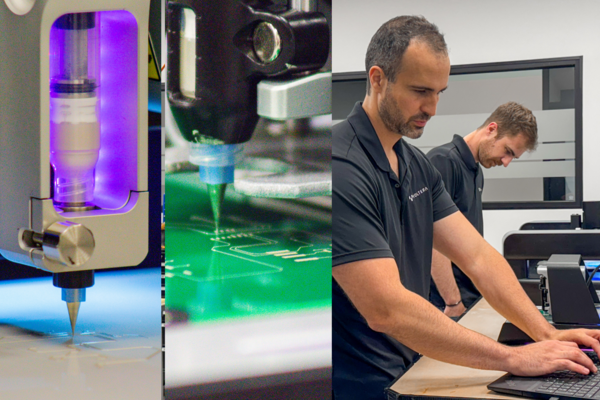
Waterloo engineer by day, circus performer by night
Graduate engineering student Sara Greenberg uses her work as a contemporary circus performer to enrich her research

Graduate engineering student Sara Greenberg uses her work as a contemporary circus performer to enrich her research
By Carol Truemner Faculty of Engineering
Systems design engineering master’s student Sara Greenberg working in Waterloo’s Motion Research Group lab with doctoral candidate Borna Ghannadi.
Before last January, Sara Greenberg often felt she was two different people. By day, she was a student working at a desk. At night, she was a circus performer flying through the air.
“It’s like I would become some type of super hero,” laughs the systems design engineering master’s candidate.
Now, Greenberg has found a direct connection between her studies and her work as a contemporary circus performer with the encouragement of her graduate supervisors Alexander Wong and John McPhee, both systems design engineering professors.
Earlier this year, Greenberg began incorporating her research in human body pose estimation and tracking into her performance work. The result was Auras, an innovative aerial performance piece with awe-inspiring live projection mapping. Auras uses a single-strand strap rigged through two points with a performer suspended on each end. The weight of each performer is supported by the other in a pulley system, driving a kinetic conversation.
Auras was presented as the Emerging Artist work at the annual Contemporary Circus Arts Festival of Toronto Showcase held in September. It was choreographed and performed by Greenberg and Valerie Arthur, a Waterloo School of Architecture alumnus. The projection was executed by Audrey Chung, a systems design engineering doctoral student.
“I love combining my interests in image processing, projection mapping and circus and exploring the relationship between technology and the individual,” says Greenberg, a member of the University’s Vision and Image Processing Lab and the Motion Research Group.
Greenberg’s passion for circus acrobatics began at age 14 while living with her family in Halifax. She became part of Cirque Siana, Atlantic Cirque’s performing troupe and has also performed with Circus Orange, Equilibrium Circus, No Parachute Theatre and many other groups.
“What began as a hobby quickly took over my life in the best way possible,” she recalls.

Waterloo engineering student Sara Greenberg and Waterloo architecture alumnus Valerie Arthur performing in a contemporary circus production.
She continued perfecting her contemporary circus skills while an undergraduate engineering student at Waterloo. After graduating in 2014, she was hired by the Toronto Star as a web developer and worked part time at Cirque-ability where she taught the adult performance team. Among her students at the Toronto aerial and acrobatics studio was Arthur who became Greenberg’s performance partner. Arthur recently moved to Chicago to train full time as a circus performer.
After a year at The Star, Greenberg became restless and decided to return to Waterloo for her master’s degree.
“I love to solve problems,” she says. “My fourth-year project was an image processing sign language learning system. I wanted to solve more problems and create more exciting things.”
One of those things she’s helping create is a posture-tracking system to ensure stroke patients and others using a rehab robot are engaging the correct muscles.
In her spare time, Greenberg works at Brass Butterflies and Circus in the Trees and occasionally fills in for instructors at Cirque-ability. She has also founded Sky Kaleidoscope, a circus and projection arts collective that focuses on creating art using both the body and technology.
Next up for Greenberg and her circus work is Cirque-It to be held December 1 in Toronto. The interactive event showcases the work of teams comprised of wearable-tech makers/developers, fashion designers and performers.
While still in the planning stages with her newly formed Cirque-It team one thing is certain: Greenberg is bound to reach new creative heights with her next performance.

Read more
Meet five exceptional Waterloo graduate students crossing the convocation stage as Class of 2025 valedictorians

Read more
Waterloo Engineering alum wears her iron ring proudly while building her career in quantum tech in Germany

Read more
Voltera prints electronics making prototyping faster and more affordable — accelerating research to market-ready solutions
Read
Engineering stories
Visit
Waterloo Engineering home
Contact
Waterloo Engineering
The University of Waterloo acknowledges that much of our work takes place on the traditional territory of the Neutral, Anishinaabeg, and Haudenosaunee peoples. Our main campus is situated on the Haldimand Tract, the land granted to the Six Nations that includes six miles on each side of the Grand River. Our active work toward reconciliation takes place across our campuses through research, learning, teaching, and community building, and is co-ordinated within the Office of Indigenous Relations.